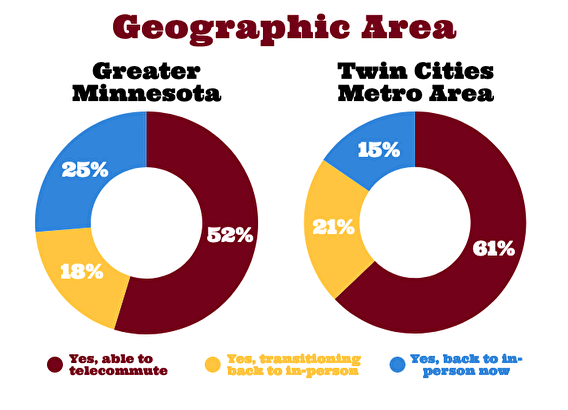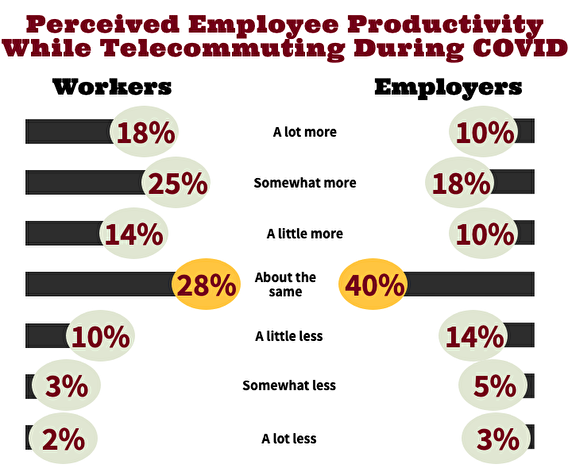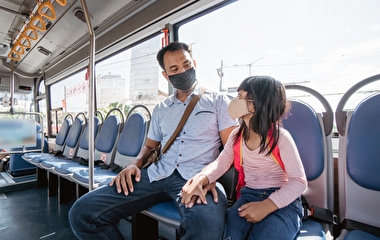
When the COVID-19 pandemic began—and for the first time in history—a large portion of Minnesota’s workforce shifted temporarily to telecommuting. What were the impacts of so many people working from home, and what could our state’s transportation agencies learn that might help in their planning efforts?
The Minnesota Department of Transportation (MnDOT) sponsored research to find out. Xinyi Qian, director of the University of Minnesota Tourism Center, led a team that gathered feedback from employers and workers about their experiences around telecommuting.
Specifically, the researchers assessed the impacts of the shift on workplace policy changes and support for telecommuting and on potential population migration by employees. To do so, they looked at how the impacts differed based on employees’ demographic characteristics, life circumstances, and geographic locations. Separate online surveys were sent to employers and workers between July and September 2021 asking for feedback about what they experienced and what they expect post-pandemic.
The final report is rich with data. “From our worker survey, we found that geographic area, life circumstances, and demographic characteristics all made differences in telecommuting availability and average weekly telecommuting hours,” Qian says. “Likewise, these three factors shape the possibility of post-pandemic telecommuting and telecommuting frequency.”

For example, Twin Cities metro respondents were more likely to still telecommute at the time of the survey, while respondents from outside the metro were more likely to have returned to in-person work or had never received the option to telecommute. However, “in terms of the potential to telecommute post-pandemic, nearly identical percentages of Twin Cities and Greater Minnesota respondents would be able to telecommute four to five days a week,” she says.
Having children living at home was another factor that accounted for differences. Workers with children at home were more likely either to be back at in-person work or transitioning back to it at the time of the survey. They were also more likely to have a formal post-pandemic telecommuting agreement with their employers.
Workers without children living at home were more likely to telecommute four to five days a week post-pandemic. This insight corresponded with the finding that baby boomers—who are more often empty nesters—were most likely to telecommute at this frequency. “Popular perception regards younger workers as digital natives, and therefore more likely to telecommute,” Qian says. “Our findings painted a different picture: It was the Gen Z respondents who were most likely to telecommute no more than one day per week post-pandemic.”
Education level and household income also made significant differences in average weekly telecommuting hours and possible post-pandemic telecommuting frequency. Compared to all other respondents, workers with a high school education or less—and those with a household income of $50,000 or less—had significantly fewer weekly telecommuting hours and were much more likely to telecommute no more than one day a week post-pandemic.
There was also a significant racial difference in average weekly telecommuting hours. White respondents had significantly higher weekly telecommuting hours during the pandemic compared to respondents of all other races, Qian says.
Employers were split in terms of future telecommuting frequency. While close to half of respondents indicated they would support telecommuting for anywhere between one and five days a week, another quarter said they would only support infrequent (less than one day a month) telecommuting post-pandemic. “A little more than a quarter of respondents said their organizations may recruit talent from outside of Minnesota who will work completely remotely,” Qian adds.

The worker and employer surveys found some different views of telecommuting experiences during the pandemic. Employer representatives were more likely to perceive no change in expectations of employee performance, while workers tended to perceive higher expectations. Workers were also more likely to perceive themselves as more productive, while employer representatives tended to perceive employee productivity as either not having changed or having declined.
The team developed the surveys after listening to focus groups of human resources professionals, conducting a literature review, and working with the project’s technical advisory panel.
Duane Hill, transportation engineer for MnDOT District 1 and the technical liaison for the project, says the research provides much-needed data-driven evidence about the impact of telecommuting in Minnesota. “At the beginning of the pandemic, we saw a huge change on our roadways,” he said. “This research gives us insight into what employers and employees are going to be doing relative to traffic patterns and congestion when this pandemic is finally over.”
Hill also indicated this research could have impacts for the work MnDOT’s Sustainable Transportation Advisory Council is doing around reducing vehicle-miles traveled (VMT) in the state. “If we have this goal of reducing VMT 20 percent per capita, then having workers who can…telecommute one or two days a week would make a really huge difference.”
To view more infographics related to this research, visit the Minnesota Local Road Research Board's project page.


